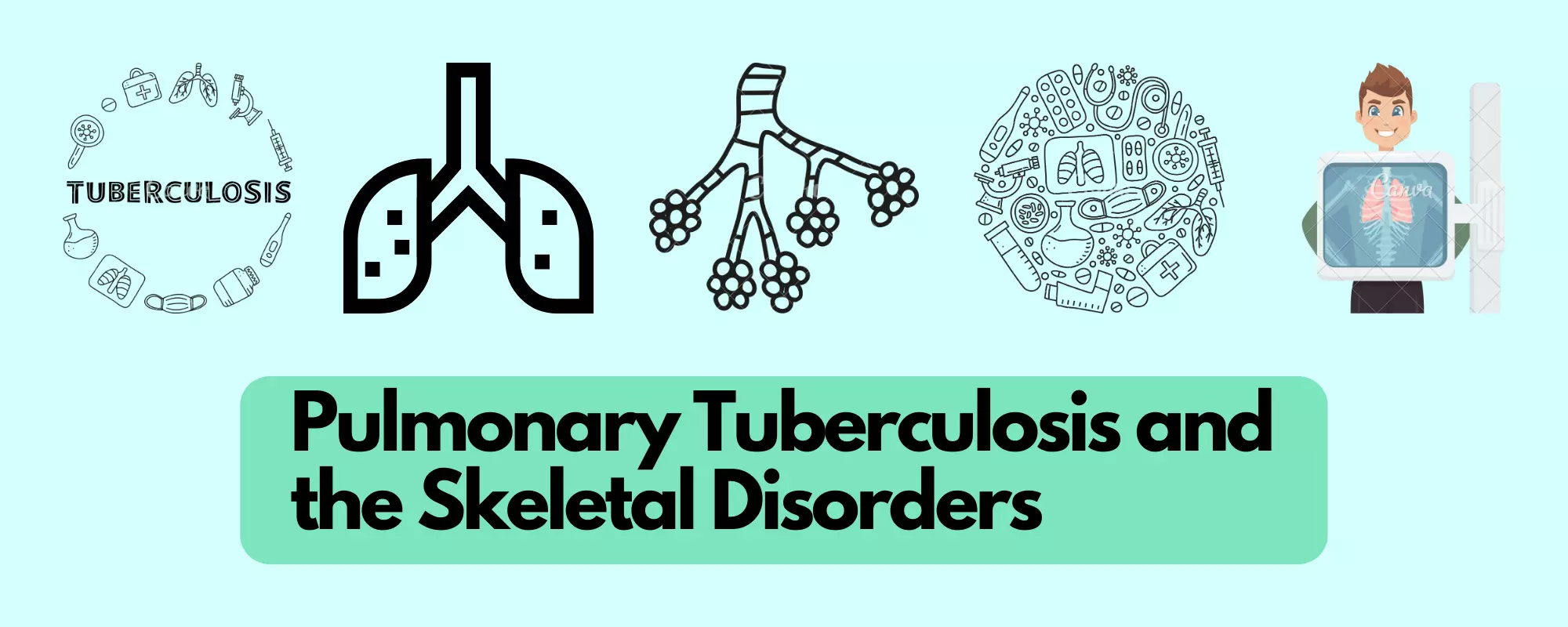Pulmonary Tuberculosis and the 3 Skeletal Disorders Potentially Linked to It
We have so many health disorders that are linked with each. We require proper treatment of each disorder to get rid of all the linked disorders. We have our organs in one body. These are connected in one or the other way. When our one organ gets disturbed our whole body feels the pain. These organs and their processes and working are linked with each other. Pulmonary tuberculosis and skeletal disorders are also linked with each other. Today we will discuss both.
Table of Contents
Pulmonary Tuberculosis
Pulmonary Tuberculosis (TB) is a highly contagious chronic bacterial infection primarily affecting the lungs. The condition involves the bursting of alveoli and their replacement with inelastic connective tissue. Lung tissue cells respond by forming protective capsules called tubercles. However, these tubercles can rupture, releasing bacteria that can infect other parts of the lung.

Causes of Pulmonary Tuberculosis
The main cause of pulmonary tuberculosis is Mycobacterium tuberculosis, a bacterium responsible for the infection. Common symptoms include a low-grade intermittent fever, especially in the evening, night sweats, weight loss, loss of appetite, malaise or depression, dry cough with sputum, and a dull chest ache caused by pleurisy, which is inflammation of the pleura surrounding the lungs.
Treatment of Pulmonary Tuberculosis
To treat pulmonary tuberculosis, the recommended approach is the Daily Observed Treatment Short-course (DOTS) regimen. This involves the regular intake of medication for nine months under supervision to ensure complete eradication of the disease.
Pulmonary Tuberculosis and Skeletal Disorders
The link between pulmonary tuberculosis and skeletal disorders can be understood by studying the spread of the bacteria from the lungs to the skeletal system. Here’s how it can happen:
Hematogenous spread
TB bacteria can spread widely through the bloodstream, reaching different organs and tissues, including the bones. This path of the spread of TB bacteria is responsible for most skeletal tuberculosis cases. When TB bacteria reach the bone, they cause inflammation and destruction, which leads to skeletal disorders such as osteomyelitis, septic arthritis, or tuberculous spondylitis (Pott’s disease).
Direct extension
In some cases, the infection spread directly from the nearby pulmonary structures to the attached bones. This happens when the TB bacteria gradually destroy the lung tissue and extend into the pleural space, chest wall, or mediastinum, finally reaching the ribs or sternum.
Skeletal Disorders
In addition to pulmonary tuberculosis, three skeletal disorders may potentially be linked to the condition:

Slipped Disc
Intervertebral discs in the spine consist of a semi-fluid nucleus pulposus surrounded by a strong outer ring of fibrocartilage known as the annulus fibrosus. These discs serve as shock absorbers and provide some lateral flexibility. However, sudden trauma or strenuous movements, such as bending forward while lifting a heavy object, can cause one or more discs to herniate.
This condition, commonly referred to as a slipped disc, occurs when the annulus fibrosus ruptures, allowing the spongy nucleus pulposus to protrude. A slipped disc can exert pressure on the spinal cord or nerves, resulting in severe pain or damage.
Treatment
Disc slip is treated with bed rest, traction (Pulling), and painkiller.
If this fails, the disc may be removed surgically.
Spondylosis
Spondylosis is characterized by the immobility and fusion of vertebral joints. Cervical spondylosis specifically occurs due to chronic degeneration in the cervical spine, often involving disc herniation and age-related changes.
Sciatica
Sciatica manifests as sharp, radiating pain along the path of the sciatic nerve. It may be accompanied by weakness, numbness, or tingling sensations in the leg. Common causes of sciatica include nerve injury or compression, slipped discs, pelvic injuries or fractures, and tumors.
Recovery from sciatic nerve injuries is typically slow and may not be complete.
These skeletal disorders require various treatments, including rest, traction (pulling forces), pain relief medications, and, in some cases, surgical intervention if conservative measures prove ineffective.
How does Pulmonary tuberculosis affect the skeletal system?
Tuberculosis (TB) can affect the skeletal system by the spreading of bacteria to the bones and joints, leading to a condition known as skeletal tuberculosis or tuberculous osteomyelitis. The infection causes inflammation, destruction, and other skeletal disorders. Mostly, it affects the spine, leading to vertebral collapse, spinal deformity, and compression of the spinal cord or nerves.
TB is also responsible for weight-bearing joint pain, swelling, stiffness, and joint destruction. Moreover, it can affect long bones, ribs, and other skeletal structures, leading to localized bone destruction and related symptoms.
The exact mechanisms involve the spread of TB bacteria through the bloodstream or direct extension from adjacent structures. Early diagnosis and treatment are important to prevent further damage and complications. Treatment usually involves a prolonged course of anti-tuberculosis medications, and surgical intervention may be necessary in some cases.
Read Article on Biological Sciences and Human Welfare!
What is the most common bone affected in TB?
The most common bone affected by tuberculosis is the spine, the vertebral column, more specifically the thoracic and lumbar regions of the body bones. When TB bacteria spread to the bones, it leads to a disease known as Pott’s disease or tuberculosis spondylitis.
Can TB cause kyphosis?
Yes, spinal tuberculosis (TB) can cause kyphosis, particularly in cases of Pott’s disease or tuberculous spondylitis. Pott’s disease is a type of skeletal tuberculosis that primarily affects the spine. When TB bacteria infect the vertebral bodies and adjacent intervertebral discs, it can lead to their destruction and collapse. As a result, the affected portion of the spine can develop an abnormal forward curvature, resulting in kyphosis.
Can TB cause bone damage?
Yes, tuberculosis (TB) can cause bone damage. When Mycobacterium tuberculosis, the bacteria that cause TB, enters the bones and joints, several conditions of bone disorders develop.





